Complete Solutions to SECTION -E(MULTIPLE CHOICE QUESTIONS) (MCQS) of chapter LAW OF MOTION of Class 11 book with complete answers and questions
| Class 11 | PHYSICS |
| Chapter | LAW OF MOTION |
| KUMAR PRAKASHAN | SECTION -E(MULTIPLE CHOICE QUESTIONS) (MCQS) |
| Number Of Questions | 69 |
| Academic Year | 2023-24 |
The position (x) `rarr` time (t) graph of one dimensional motion of a body of mass 0.4 kg. What is the magnitude of impulse of force
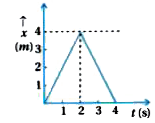
View SolutionWhat is time period of a simple pendulum in a freely falling lift ?
View SolutionArrangem ent in which the pulley are smooth and strings are of negligible mass. For the system to remain in equilibrium, the angle 0 should be .....
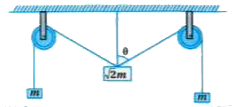
View SolutionA circular racetrack of radius 300 m is banked at an angle of `20^(@)`. If the coefficient of friction between the wheels of the race car and the road is 0.2, what is the approximate maximum permissible speed of the race car ? `
View SolutionWhen 20 N force is applied on a body of mass m, acceleration 8.0 `ms^(2)` is produced in it. The same force when applied on a body of mass m', acceleration of 24 `ms^(2)` is produced. What will be acceleration produced by the same force applied on these two bodies tied togather......
View SolutionA bomb in the steady state explodes into three fragments. Two fragments of equal masses move with velocity 15 `ms^(-1)` in mutually perpendicular directions. The mass of the third fragment is equal to three times the mass of each of these two fragments. The magnitude of velocity of third fragment is `ms^(-1)` .
View Solution6 bullets are fired in a second from a machine gun with velocity of 400 `ms^(-1)`. The mass of machine gun and bullet are 10 kg and 30g respectively. What is the value of force is to be exerted on machine gun to keep it stationary ?
View SolutionA ball of mass of 150g and velocity 12 `ms^(-1)` coming towards a batsman is hit by him with a force in such a way that the ball moves with velocity 30 `ms^(-1)` in the direction opposite to its original one. The time of contact between the ball and the bat is 0.01 s. Then the force applied on it by the batsman i s .......
View SolutionA block of mass 15 kg is lying on an inclined plane of angle `30^(@)`. In order to make it move upward along the slope with an acceleration 25 `cms^(2)`, a horizontal force of 200 N is required to be applied on it. Then the frictional force on the block i s (g = 9.8 ms 2)
View SolutionIf P, v and E denotes the momentum, velocity and K.E. of a particle then ......
View SolutionA block (A) of mass 20 kg is put on a frictionless surface and another object (B) of mass 2 kg is placed over it. The coefficient of friction between the surface of A and B is 0.25. If a horizontal force of 10 N applied on B, then acceleration of A and B are respectively......

View Solutionforce F = 100 N is applied horizontally on a block of mass 4 kg. Which is in contact with a wall. Such that it does not fall. The coefficient of friction between the block and the wall is
View SolutionThe SI unit of time rate of change of momentum is ………..
View SolutionA stationary bomb explodes into three fragments. If the linear momentum of two A pieces are `4hati` and `3hatJ` unit respectively, then what is the value of the third fragment ?
View SolutionThe linear momentum of a particle at time t is given by the equation P = x + `yt^(2)`, where x and y are constants. The instantaneous force acting on the particle during its motion is .....
View SolutionIf linear momentum of a body is increased by 0.5% its kinetic energy increases b y ..
View SolutionF `rarr` t graph for a body is shown in figure. The change in value of momentum of the body in the interval 0.02 s to 0.06 s is ..
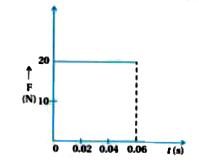
View SolutionWhen a force acts on a body of mass 200 gram the change in its velocity is 15 cm `s^(-1)` per second. The magnitude of this force is ......Newton.
View SolutionA car of mass 1000 kg is moving with a velocity 20m /s on a horizontal straight road. If the driver applies brakes to produce a constant breaking force of 5000 Newton, the acceleration of the car i s ..... m /`s^(2)`.
View SolutionThe value of co-efficient of static friction `(mu_(s))` is in the range between.
View SolutionA force acts on an object of mass 2 kg at rest, for 0.5 s. After the force stops acting, the object travels a distance of 5 m in 2 s. Hence the magnitude of the force will be …
View SolutionA person of mass 60 kg is standing on a raft of mass 40 kg in a lake. The distance of the person from the bank is 30 m. If the person starts running towards the bank with velocity 15 m/s, then what will his distance be from the bank after two second
View SolutionA block of 50 kg on a smooth plane inclined at `60^(@)` and another block of 30 kg on a smooth plane inclined at `30^(@)` with horizontal are connected by a light string passing over a frictionless pully as shown in the figure. Take g = `10 ms^(-2) , sqrt(3) =1.7`. The acceleration of the blocks and tension in the string are.
View SolutionIf the speed of a vehicle become 3 times for a given deceleration its stopping distance become .....
View SolutionIf vectors are `vecA = 2 hati + 3 hatJ - hatk` and `hatB = 4 hati + 6 hatJ - 2 hatk` , then they are .........
View Solution`vecA = 2 hati +3 hatJ +4 hatk` and `vecB =4 hati +5 hatj +3 hatk` , then the magnitudes of `vecA -vecB`…unit
View SolutionFind the vector product of vectors `vecA = 4hati + 2 hatJ - hatk ,vecB = hati+ 3 hatJ + 4 hatk`
View SolutionA body of mass 20 kg at one end and another of 60 kg at the other end of a string passing over a frictionless pully are suspended as shown in the figure. Acceleration of this system is `m/s^(2)`.
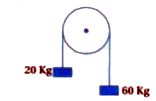
View SolutionIf vector `vecA =4 hati -6 hatJ +2hatk` and `vecB =6hati +8 hatj +mhatk` are m utually perpendicular, m = ....
View SolutionRamesh with mass of 65 kg stands on a spring balance in a lift. If the lift moves in upward direction with an acceleration of 3 m/`s^(2)`, then the weight of Ramesh will becom e........
View SolutionThe potential energy of a projectile at its highest point is`3/4` of the value of its initial kinetic energy. Therefore its angle of projection is ..........
View SolutionA block of mass 20 kg is lying on an inclined plane of angle `30^(@)`. In order to make it move upward along the slope with an acceleration of 25 cm/`s^(2)`, a horizontal force of 400 N is required to be applied on it. (i) Frictional force on the block is .......N. (ii) Co-efficient of kinetic friction i s .........
View SolutionM = 5 kg. The co-efficient of static friction between the block and the surface
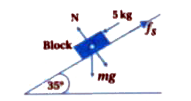
View SolutionA body of mass 10 kg at rest is applied with perpendicular force of 4 N and 3 N at the same time, then at the end of 10 seconds its kinetic energy = .........
View SolutionThe angle between `vecF =(1,-3, 1)`and `vecd =(2,-3,-11)` will b e ...... rad.
View SolutionA disc is rotatin g aro u n d its cen tre in a horizontal plane at the rate of 60 rotation/ minute. A coin `(1A^(st))` is placed at a distance of 18 cm and `2^(nd)` similar coin 20 cm from its centre. The co-efficient of static friction between the disc and the coins is 0.2. Which coin will be thrown away from the disc ? Which coin will keep rotating with the disc ?
View SolutionA bomb in the steady state explodes into three fragments. Two fragm ents of equal masses move w ith velocity 30 m /s in m utually perpendicular direction. The mass of the third fragment is equal to five times the mass of each of these two fragm ents. Find the magnitude and direction of the velocity of this third fragment.
View SolutionBlock of mass m is placed on frictionless slope with angle 0. Normal force acting on block due to surface will be .....
View SolutionThe upper half of an in clin ed plane of inclination `30^(@)` is perfectly smooth, while the lower half is rough. A block starts from rest from the top of the plane and if it comes back to rest at the bottom, what is the co-efficient of kinetic friction between the surface of block and the rough surface of the inclined plane ?
View SolutionWhen a force acts on a body of mass 0.1 kg, the change in its velocity is 20 cm `s^(-1)` per second. The magnitude of this force is ..... N
View SolutionA force of 8 N acts on an object of mass 2 kg in X-direction and another force of 6 N acts on it in Y -direction. Hence, the magnitude of acceleration of the object will be ....
View SolutionThree blocks with masses m, 2m and 3m are connected by strings as shown in the figure. After an upward force F is applied on block m, the masses move upward at constant speed v. What is the net force on the block of mass 2m
View SolutionA rod PQ of mass M and length L is hinged at end P. The rod is kept horizontal by a massless string tied to point Q as shown in figure. When string is cut, the initial angular acceleration of the rod is

View SolutionAn explosion breaks a rock into three parts in a horizontal plane. Two of them go off at right angles to each other. The first part of mass 1 kg moves with a speed of 12 `ms^(-1)` and the second part of mass 2 kg moves with 8 `ms^(-1)` speed. If the third part flies off with 4 `ms^(-1)` speed, then its mass i s .....
View SolutionThe u p p er half of an in clin ed p lane of inclination `theta` is perfectly smooth while lower half is rough. A block starting from rest at the top of the plane will again come to rest at the bottom, if the coefficient of friction between the block and lower half of the plane is given by
View SolutionA system consists of three masses `m_(1) m_(2)` and `m_(3)` connected by a string passing over a pulley P. The mass `m_(1)` hangs freely and `m_(2)` and `m_(3)` are on a rough horizontal table (the co efficient of fircition = p). The pulley is frictionless and of negligible mass. The downward acceleration of mass `m_(1)` is (Assume`m_(1) - m_(2) = m_(3) = m`)
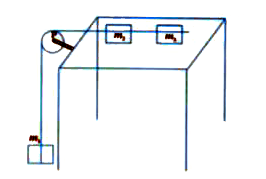
View SolutionThe force ‘F’ acting on a particle o f mass ‘m ’ is indicated by the force-time graph shown below.
The change in momentum of the particle over the time interval from zero to 8 s is
View SolutionA ballon with mass 'm’ is descending down with an acceleration ‘a' (where `a le g`). How much mass should be removed from it so that is starts moving up with an acceleration ‘a ’ ?
View SolutionA body of m ass (4m) is lying x-y p lan e at rest. It su d d en ly explodes in to th re e pieces. Two pieces, each of m ass (m) m ove p erp en d icu lar to each o th er w ith equal speeds (p). The total kinetic energy g en erated due to explosion is
View SolutionThree blocks A, B and C of m asses 4kg, 2kg and lkg respectively are in con tact on a frictionless surface, as show n. If a force of 14 N is applied o n th e 4kg b lo ck , th e n th e c o n ta c t fo rce betw een A and B is
View SolutionA block A of m ass rests on a horizontal table. A lig h t strin g connected to it passesover a frictionless pulley at the edge of table an d from its other end another block B of mass `m_(2)` is su sp en d e d . The co efficien t of k in eticfriction between the block and the table is `mu_(k)` hen the block A is sliding on the table, the ten sio n in the string i s :
View SolutionA plank w ith a box on it atone end is gradually raised about the other end . As the ang le of in clin ation with the horizontal reaches `30^(@)`, the box starts to slip and slides 4.0 m down the plan k in 4.0s. The coefficients of static and k inetic friction between the box and the plank will be, respectively:

View SolutionA particle moves so th at its p o sitio n vector is `omega` Where is a constant which of the following is true
View SolutionWhat is the minimum velocity with which a body of mass m must enter a vertical loop of radius R so that it can complete the loop
View SolutionA rigid ball of mass m strikes a rigid wall at 60° and gets reflected without speed shown in the figure below .The value of impulse imparted by the wall on the ball will be ....
View SolutionA bullet of m ass 10 g m oving horizontal w ith a velocity of 400 `ms^(-1)` strikes a w ood block of m a ss 2 kg w h ic h is s u s p e n d e d by lig h t inex ten sib le strin g of length 5 m. As resu lt the c e n tre of gravity of th e block fo und to rise a v ertical distan ce of 10 cm . The sp eed of the bullet after it em erges on horizontally from the block will b e ......
View SolutionA stationary object is divided into two fragment of mass 2M and 3M. Total energy of both fragment is E. Find energy of fragment with mass 2M.
View SolutionA cyclist on a level road takes a sharp circular tu rn of rad iu s 3 m (g = 10 `ms^(- 2)` ). If th e coefficient of static friction between the cycle tyres and the road is 0.2, at which of the following speeds will the cyclist not skid while taking the turn ?
View SolutionWhen forces `F_(1), F_(2)` and `F_(3)` are acting on a particle of mass m such that `F_(2)` and `F_(3)` are m utually perpendicular, then the particle remains stationary. If the force F x is now removed, then the acceleration of the particle is .........
View SolutionWhen forces `F_(1), F_(2)` and `F_(3)` are acting on a particle of mass m such that `F_(2)` and `F_(3)` are m utually perpendicular, then the particle remains stationary. If the force F x is now removed, then the acceleration of the particle is .........
View SolutionTwo masses `m_(1)` = 4.8 kg and `m_(2)` = 5 kg tied to a string are hanging over a light frictionless pully. What is the acceleration of masses when they are free to move ?
View SolutionA block rests on a rough inclined plane making an angle of 30° with the horizontal. The coefficient of static friction between the block and the plane is 0.8. If the frictional force on the block is 10 N, the mass of the block ((in kg) is .......... (Take g = 10 `m//s^(2)`)
View SolutionA person fire bullet of 40 g w ith speed of 1200 m /s from his rifle. If rifle can w ithstant maximum recoil force of 144 N. How many bullet he can fire every second ?
View SolutionA player caught a cricket ball of m ass 150 g moving at a rate of 20 `m //s^(- 1)` . If the catching process is com pleted in 0.1 s, the force of the blow exerted by the ball on the hand of the player is equal to .....
View SolutionA mass ‘m’ is supported by a massless string wound around a uniform hollow cylinder of mass m and radius R. If the string does not slip on the cylinder, with what acceleration will the mass fall on release ?

View SolutionGiven in the figure are two blocks A and B of weight 20 N and 100 N respectively. These are being pressed against a wall by a force F as shown. If the coefficient of friction between the blocks is 0.1 and between block B and the wall is 0.15, the frictional force applied by the wall on block B is

View SolutionTwo masses `m_(1)` = 5 kg and `m_(2)` = 10 kg, connected by an inextensible string over a frictionless pulley are moving as shown in the figure. The coefficient of friction of horiztonal surface is 0.15. The minimum height m that should be put on top of `m_(2)` to stop the motion is
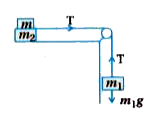
View SolutionWhich one of the following statem ents is incorrect?
View SolutionA block of mass m is place on a sm ooth inclined wedge ABC of inclination 0 as shown in figure. The wedge is given an acceleration ‘a’ towards the right. The relation between a and `theta` for the block to rem ain stationary on the wedge is

View Solution
SECTION -E(MULTIPLE CHOICE QUESTIONS) (MCQS) questions and complete solutions for chapter LAW OF MOTION of KUMAR PRAKASHAN KENDRA PHYSICS (GUJRATI ENGLISH) of Class 11
All Exercises from KUMAR PRAKASHAN Class 11 PHYSICS LAW OF MOTION
- (QUESTION PAPER) SECTION-A
- (QUESTION PAPER) SECTION-B
- (QUESTION PAPER) SECTION-C
- (QUESTION PAPER) SECTION-D
- SECTION -B (ADDITIONAL EXERCISE )
- SECTION -B (NUMERICAL FROM DARPAN BASED ON TEXTBOOK)
- SECTION -B (NUMERICAL FROM TEXTUAL EXERCISE)
- SECTION -B (NUMERICAL FROM TEXTUAL ILLUSTRATION)
- SECTION -E(MULTIPLE CHOICE QUESTIONS) (MCQS)
- SECTION-A(QUESTION PAPER)
- SECTION-A(TRY YOURSELF)(VSQS)
- SECTION-C(OBJECTIVE QUESTIONS) (VSQS)
- SECTION-D(NCERT EXEMPLAR SOLUTIONS)
- SECTION-F (QUESTIONS FROM MODULE)